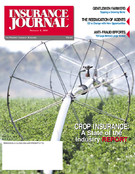Last year was an eventful one for the crop insurance industry with a new farm package including modifications such as an $8 billion subsidy package and a $7.1 billion bailout for farmers hurt by depressed crop prices. It was also the year of a near miss by bankers to direct-sell crop insurance.
Meanwhile, drought conditions through many crop-growing states added to the roller coaster ride that was the 2000 farming year, leaving many growers wondering if they should have even bothered harvesting their often pitiful crop yields.
The end result was an expected average premium increase of 7 percent for multiple peril crop insurance, marking the fifth consecutive year premiums have risen that much. Fortunately for farmers and agents, the Congressional subsidies will more than offset that amount, allowing farmers to bump up their coverages for only slightly more money. But getting farmers to do that is often impossible as many agents selling crop insurance know.
“It’s getting to where the coverage isn’t worth it to some farmers because the premium is so high,” said Paige Eiland, president of Eiland & Assoc. in Stanton, Texas. “There’s a lot wrong with the [crop insurance] program, but if it weren’t for the program, there’d be a lot of farmers that went out of business a long time ago.”
Some people in the industry say Congress itself is to blame for farmers’ continued reticence to purchase crop insurance. The 2000 farm rescue package approved by Congress and former President Clinton marked the third federal bailout for ranchers and growers in as many years. And since 1988, Congress has approved more than $15 billion in emergency farm aid.
“The more coverage that we as agents can bring in at higher coverage levels, the less need Congress will have to come in and write checks for emergency relief,” said Tom McCrocklin, director of federal affairs for the Independent Insurance Agents of America. “It’s going to take a little discipline by Congress to say ‘look, we want you to be a part of this crop insurance program—we’re not going to continue to bail you out.'”
In 2000, national crop insurance written liability topped $34 billion, more than 11 times the amount written just 20 years prior. Paid losses for 2000 reached nearly $1.78 billion, and total premium written for the year was just less than $2.52 billion, making for a total loss ratio of 71 percent.
Compared to other lines of property/casualty insurance, these would seem like excellent figures. So why is it that companies aren’t falling over themselves to write the coverage? According to McCrocklin, it is partly due to
the labor-intensive nature of writing crop insurance.
“Crop is, by far, the most work-intensive product that my agents sell,” he said. “It’s most often used as a loss leader.” He added that expense reimbursements have dropped over the last several years from the mid-30s to just 24.5 percent today.
Also, crop insurance loss ratios come and go with the weather. Literally. That can make for some unpredictable and sometimes extreme years. For example, in 1993, loss ratios for the industry reached 219 percent, up from 121 and 130 for the two years prior. In fact, between 1980 and 1993, loss ratios averaged 157 percent with a high of 243 percent in 1988 and a low of 101 in 1987. Since then, loss ratios have averaged just 80.8 percent, with a high of 105 percent in 1999.
According to Stephen Frerichs, manager of the American Association of Crop Insurers, Congress has had a lot to do with those loss ratios improving. “The program has gone through some significant changes since 1994,” he said. “There’s broader participation among farmers than in the ’80s and early ’90s, so there’s a wider risk pool.” He estimated as much as 65 percent of the eligible acres are currently insured. A large part of the remaining 35 percent is planted with hay. Frerichs said an adequate hay coverage simply doesn’t exist, so farmers seldom purchase it.
Another factor Frerichs contributes improved loss ratios to is that no significant crop failures have occurred in the Midwest since 1993. “Traditionally, we expect one out of every five years to be a bad year and we’ve had seven good years now,” Frerichs said.
So why is it that Congress is still passing multi-billion dollar emergency rescue packages to bail farmers out?
“Part of the problem is that farmers are buying more crop than they ever have before, but they aren’t always buying enough to cover their losses,” Frerichs said.
“I think Congress would like for crop insurance to work, and they’ve changed it in 1994 and 2000 to do just that.” And while Frerichs is hesitant to say if Congress will put its foot down the next time farmers take a hard hit, and hold back on the bail-out funding, he knows it’s an issue that is being discussed. “That rhetoric is already here.”
Topics Profit Loss Agencies Agribusiness
Was this article valuable?
Here are more articles you may enjoy.


 Homes Are Taking Longer to Sell in US Markets That Once Flourished
Homes Are Taking Longer to Sell in US Markets That Once Flourished  Truckers Fear Job Loss as New English Language Rules Take Effect
Truckers Fear Job Loss as New English Language Rules Take Effect  Google Owes $314 Million for Misusing Android Cell Phone Data
Google Owes $314 Million for Misusing Android Cell Phone Data  Supreme Court Dealt Blows to EPA and Environmental Protections
Supreme Court Dealt Blows to EPA and Environmental Protections 


